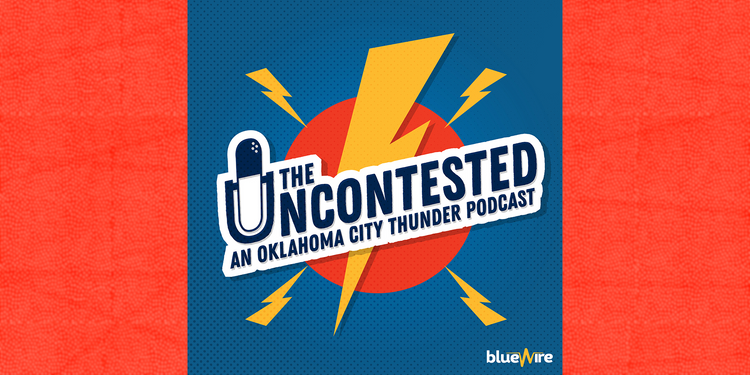Wake Up Call: Bring Back Last Season’s Pick and Roll Offense

The bread and butter of the Thunder offense is the Russell Westbrook pick and roll. A season ago, the team employed it at a historic rate, ending over 10 percent of all offensive possessions in a shot, pass, or turnover off of Westbrook’s hands coming off a ball screen, per Synergy Sports data.
That recipe worked for 47 wins in 2016-2017, which at the time was a sign that the Thunder needed to shake things up. An indication that they were never going to be good enough. That they needed to make a change. The primary problem to be solved was spacing for Westbrook to operate. Too often last season he charged into a clogged toilet bowl of defenders in the lane, throwing up a wild layup (that he made more times than he probably should have).
So in came Paul George, Carmelo Anthony, Patrick Patterson, Raymond Felton and eventually Corey Brewer, and up came minutes for shooters like Alex Abrines and Josh Heustis (ehem maybe semi-shooters). The common denominator there? All were threats from behind the arc. Spacing would not be a problem in 2017-2018.
Which is why, in a season that contains plenty of issues that deserve to be dissected, nothing is more troubling heading into the playoffs than Westbrook’s pick and roll statistics. His effectiveness is actually down, from 0.891 points per possession (71st percentile in the league) last season to 0.856 PPP (63rd percentile) this year. And his turnover percentage is up significantly, from 16.6 percent of possessions last season to an eye-popping 19.8 percent.
Heading into the season’s final week, the team needs to win two of its final three games to reach 47 wins. There’s a joke in there somewhere about greener grass. But with two of those games coming on the road against playoff teams (Rockets and Heat), it won’t be easy. After that comes a highly competitive playoff series. In all of those games, the Thunder will rely on heavy doses of Westbrook high screen and roll. So what’s the problem? Are there things that this year’s offense can actually learn from last year’s offense?
Let’s see if you can tell the difference. Here are two videos, both of Russell Westbrook pick and rolls from almost identical spots on the floor. The first is from April of 2017 and the second from January of 2018. For the purposes of objectivity, both are made baskets.
It starts with how the play is initiated. Westbrook comes right down the court, with some urgency, and is able to attack the defense before it gets totally set. It’s not transition, but last season Westbrook feasted on what NBA teams categorize as “early offense,” when the defense is still gearing up.
In comparison, this season the Thunder has opted to walk the ball up after made baskets, and often their first offensive action is an off-the-ball screen, such as the popular four-across drag screen to free Paul George on one wing. Even though the offense still cycles through to a high screen for Westbrook, it comes from a dead stop located closer to the three point line, giving him less runway to build up speed and exploit his jet engine athleticism, and by that point all five pairs of defensive eyes are watching him.
In the 2017 example, Westbrook is on the floor with Adams (screener), Kanter (non-spacer), Roberson (non-spacer) and Oladipo (semi-spacer last season). Kanter hovers in the short corner, leaving his defender helping right in the middle of the lane. Not exactly the stuff of penetrators’ dreams. And yet clearly Westbrook gets a cleaner, higher percentage shot attempt, because time and time again last season, Westbrook found himself in this situation below:

Though he charged into a clogged lane, he had more functional space. By the very nature of defenders “sagging off” they were positioned in close to the basket, giving Westbrook plenty of open court underneath the screen. This led to wide open “cotton shots” and room to explode up and over defenders. By the time he gained steam, the defense didn’t stand a chance.
“But he rejected the screen!” you say, “it’s not a fair comparison!” Take a closer look. In the 2018 example, Westbrook is playing with Adams (screener), George (spacer), Anthony (spacer), Heustis (semi-spacer). That’s a good lineup, and they’re all spread around the perimeter as you’d expect. But because Heustis is spotting up, above the free throw line because there are other shooters in the corners, his defender is able to plug up the driving lane. There’s no way Westbrook can accept Adams’ screen and move to his left, where he’ll run into both Adams’ defender and Heustis’ defender. That functional space is gone either way.

By the time Westbrook breaks down his defender, which he’s able to do because he’s the reigning MVP (don’t ever forget it), the spaced defenders also take away passing options. Westbrook can either hit his safety valve (Heustis) or try to force up a shot, all while having to go through contact instead of over it because he’s been unable to get space to explode up.
One quick fix the Thunder should experiment with? Using Jerami Grant in the Enes Kanter role. To this point, the Thunder has been infatuated with using him either as a perimeter spacer when he plays alongside Adams, or a replacement for Adams as a rim-runner and screen-setter when Adams is off the floor. How about placing him down as a short corner squatter, or bringing him up to set horns screens opposite Adams (another Stache bros favorite)?
Anything the Thunder can do to get Westbrook that functional space, and fast. Not to be too dramatic, but the fate of the season depends on it.

